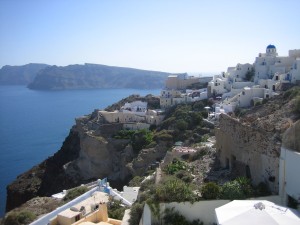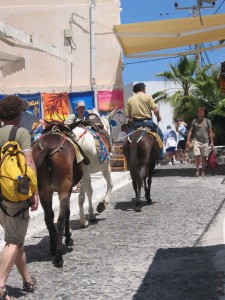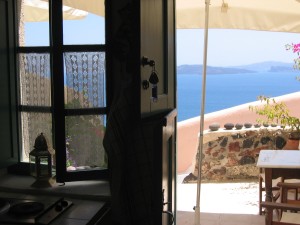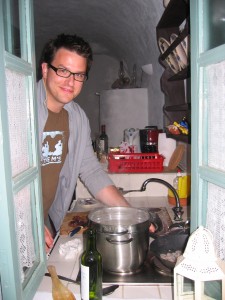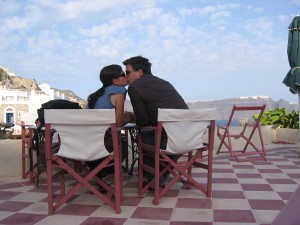There were many bodies of water to enjoy and explore at my grandparents’ cabin—it was Northern Michigan, after all, where bodies of water are as common as fields of corn where I live now, in Central Illinois.
The small, inland lakes had their appealing features: sandy shores for digging, floating rafts to dive from, and glass-like surfaces that perfectly mirrored the evening sky until the canoe you paddled broke through the stillness.
But of the many tempting bodies of water, it was the creek that enticed me most. The creek had something the lakes didn’t: It had mystery, a destination.
* * * * *
We called it simply The Creek, but on a detailed-enough map it has a proper name: Canada Creek. It probably winds for miles, but our encounters with the creek took place in the far upper-east corner of Michigan’s lower peninsula—right where the cuticle of your index finger would settle in the mitten-shaped map.
As elementary-aged kids, my older brother and I were allowed to walk together down a curving sand road until it became a one-lane bridge at the creek. The road was rarely traveled, like all the roads in the area—we were somewhere in the midst of 20 square miles of woods and water known as Canada Creek Ranch (only a fourth of which was dotted with a few hundred cabins).
At the creek, my brother and I stood on the bridge for a while, tossing stones into the water to hear them plink and plunk their varying notes. Then we slid and scrambled down the gravely bank to the creek’s shore, where we inevitably ditched our canvas sneakers and sweaty socks to wade in the cold, clear spring water. It was sandy and shallow by the bridge; I liked to stand very still, hoping a dragonfly might land on me, while the tadpoles investigated my toes.
But how long could a kid stand still in a creek? After all, the creek had places to go and things to show us.
* * * * *
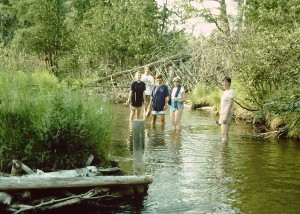 I’m guessing that we schemed and planned our first creek walk when I was about seven, sitting around Grandma’s breakfast table, pancakes piled high and studded with wild blueberries we had picked the day before. I’m sure my brother and I were persuasive in our desire to follow the creek. Not only did it beg to be further explored, but the creek held potential for so many stories. The grownups were apparently just as intrigued, because a new summer tradition was born (one that continued into our teen years, as seen in the photo): The Creek Walk.
I’m guessing that we schemed and planned our first creek walk when I was about seven, sitting around Grandma’s breakfast table, pancakes piled high and studded with wild blueberries we had picked the day before. I’m sure my brother and I were persuasive in our desire to follow the creek. Not only did it beg to be further explored, but the creek held potential for so many stories. The grownups were apparently just as intrigued, because a new summer tradition was born (one that continued into our teen years, as seen in the photo): The Creek Walk.
On Creek Walk day my brother and I set out as adventurers, eager to play the characters in our favorite books—to live out their stories, or more likely a compilation of their stories. Laura Ingalls, Davey Crockett, Lewis and Clark and Sacajawea each took a turn being embodied by us as we forged the stream.
Sometimes we talked through our stories as we walked, staying in character as we navigated over or under a fallen tree. At other moments I broke from character to yelp as I slipped on a rock and nearly went under, or to complain when my brother, leading the way, fooled us with his favorite trick: gradually bending his knees then walking on them until the water was up to his neck, which suggested it would be well over my head. (A few times he wasn’t joking, and it actually was that deep.)
And then there were spells when all of us were quiet, amazed by just how quiet the world could be, save for the swish of our legs displacing the water as we walked, and the song of a Goldfinch from somewhere above. Now that I think of it, I don’t recall ever encountering another person on our many creek walks.
* * * * *
After three or so hours of pressing on, the heat and deer flies became more bothersome, as did the ache in our legs and the rumble in our stomachs. Grandma began searching for a place to exit the creek—an opening in the tangle of brush where the bank wasn’t too steep and we could make our way from the creek’s winding world into the woods.
How Grandma had any idea where we were, I’ll never know. But she had hiked and skied those acres for years, and could confidently point us in the direction of Little Joe, one of the remote lakes on Canada Creek Ranch. We followed deer paths or forged our own way in the direction she pointed, motivated by what we knew we would find at our destination: Grandpa, firing up the grill for hotdogs. Each year on Creek Walk day he put the cooler Grandma had prepared into the car and drove the two-track roads through the woods to meet us at Little Joe’s lone picnic table.
After our feast, we all packed into Grandpa’s car, soggy and worn, to drive back to the cabin. The hotdogs and the lift home were luxuries Sacajawea never had, but by that point I was ready to be a modern-day little girl again, tucked into bed where more creek adventures could be spun in my dreams.
